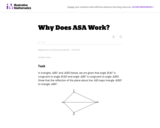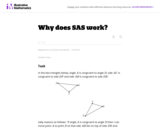
Find a quick, concise explanation of the different types of triangles. Examples are given and clearly explained.
- Subject:
- Mathematics
- Material Type:
- Reading
- Provider:
- Varsity Tutors
- Date Added:
- 05/05/2022

Find a quick, concise explanation of the different types of triangles. Examples are given and clearly explained.

If you know the length of the base and the height of a triangle, it's easy to find the area. This tutorial illustrates how to plug the numbers into the formula for the area of a triangle and solve. [3:44]

You can find the area of a triangle by using the same formula for the area of a parallelogram. Watch this tutorial to see how it's done. [4:44]

Video provides an introduction to the Pythagorean theorem and shows how it is used to solve for a missing length on a right triangle. [3:54]

The Law of Sines helps with finding a missing side or angle measurement of a triangle. Watch this tutorial to learn about this proportion. [5:57]

The triangle congruence criteria, SSS, SAS, ASA, all require three pieces of information. It is interesting, however, that not all three pieces of information about sides and angles are sufficient to determine a triangle up to congruence. In this problem, we considered SSA. Also insufficient is AAA, which determines a triangle up to similarity. Unlike SSA, AAS is sufficient because two pairs of congruent angles force the third pair of angles to also be congruent.

The two triangles in this problem share a side so that only one rigid transformation is required to exhibit the congruence between them. In general more transformations are required and the "Why does SSS work?'' and "Why does SAS work?'' problems show how this works.

For these particular triangles, three reflections were necessary to express how to move from ABC to DEF. Sometimes, however, one reflection or two reflections will suffice. Since any rigid motion will take triangle ABC to a congruent triangle DEF, this shows the remarkable fact that any rigid motion of the plane can be expressed as one reflection, a composition of two reflections, or a composition of three reflections.

This particular sequence of transformations which exhibits a congruency between triangles ABC and DEF used one translation, one rotation, and one reflection. There are many other ways in which to exhibit the congruency and students and teachers are encouraged to explore the different possibilities.

This MathWorld site gives a visual description of dilation and the different kinds of dilation in a similarity transformation.

This site from MathWorld.com offers extensive information on right triangles. The site contains information on numerous characteristics of right triangles, including constructing similar inscribed triangles, altitudes, Pythagorean triplets, and much more.